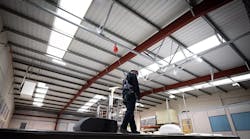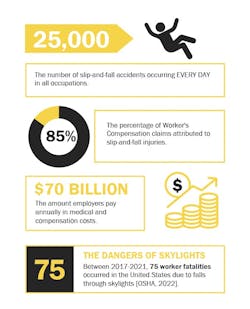A Guide to Enhancing Fall Safety in the Workplace
Editor's Note: Daniel Huntington delivered a webinar on fall protection that can be accessed for free, on-demand, here.
In the realm of occupational safety, few challenges are as widespread and critical as ensuring effective fall protection in the workplace. For workers engaged in long-term building maintenance, the dangers posed by inadequate fall safety measures can not only be severe but life-threatening.
This article shines a light on common hazards associated with workplace falls and outlines the essential strategies needed to counter them effectively. There is a particular focus on adhering to General Industry fall safety standards, which are instrumental in preventing hazardous incidents. By understanding and implementing these strategies, businesses can significantly enhance the safety and security of their workers, minimizing the risk of falls and other related accidents.
Understanding General Industry Fall Safety Standards
Unlike the construction industry-focused codes that apply primarily during the erection or remodeling of buildings, General Industry codes govern the ongoing operations and maintenance activities that are integral to a business’s daily function. These standards are crucial for preventing falls from roofs, which remain one of the leading causes of workplace injuries and fatalities.
Familiarity with these regulations is not just recommended but essential for creating a secure and compliant work environment. This knowledge helps maintenance staff and other employees navigate their duties with an informed awareness of their surroundings, significantly reducing the likelihood of accidents and ensuring a safer workplace for everyone involved.
The Hierarchy of Fall Protection Explained
Creating a safe workplace begins with a thorough understanding and application of the Hierarchy of Fall Protection (Figure 1). This structured, four-level framework is designed to systematically eliminate or mitigate fall hazards by prioritizing the most effective means of prevention first, and resorting to less desirable methods only when higher-level measures are not feasible. Here’s a detailed look at each of the levels within this crucial safety hierarchy:
1. Elimination of Risks
The pinnacle of the hierarchy focuses on the elimination of fall risks altogether, which is by far the most effective method of protecting workers. Measures at this level include performing tasks on the ground whenever feasible or utilizing extendable tools that allow tasks to be completed from a safe distance, thereby avoiding the necessity of working from heights. Strategic planning during the project design and development phase can facilitate the incorporation of such risk elimination techniques.
2. Collective Systems
The second tier involves the implementation of collective protective measures that safeguard all workers present in an area without requiring their active participation. Examples of these measures include the installation of guardrails and safety nets. These systems are designed to provide a passive form of protection that secures the entire worksite, thereby reducing the reliance on individual compliance with safety protocols.
3. Work Restraint Systems
This level of the hierarchy aims to prevent access to areas where falls can occur. Work restraint systems involve the use of equipment such as body belts or harnesses combined with lanyards that tether the worker to a secure anchor point. These restraints are configured to prevent the worker from reaching an edge or other hazard zones, effectively reducing the risk of falls by restricting movement to safe areas only.
4. Fall Arrest Systems
At the bottom of the hierarchy are fall arrest systems, which are employed as a last resort. These systems do not prevent falls but are designed to safely stop a fall in progress before the worker strikes a lower level. Fall arrest equipment includes full-body harnesses, shock-absorbing lanyards, and lifelines. It is crucial that these systems are correctly installed and that workers are properly trained in their use to ensure they function as intended during a fall.
By adhering to this hierarchy, organizations can systematically address the risks associated with working from heights and ensure they have explored all possible options to make such activities safer for their employees. This approach not only helps in complying with safety regulations but also significantly enhances the overall safety culture within the workplace, promoting a proactive stance towards the prevention of workplace injuries and fatalities related to falls.
Identifying Danger Zones
In order to enhance workplace safety, it is crucial to identify and meticulously address several commonly encountered danger zones. Effective management of these areas significantly reduces the risk of accidents and injuries, particularly in environments such as rooftops, where the potential for falls is high. Below are detailed explanations of these danger zones and practical strategies for mitigating associated risks:
1. Access Points
Accessing rooftops involves navigating potential hazards that can pose serious risks to safety. To ensure safe access, it’s imperative to install self-closing gates and railing systems that meet or exceed safety standards. These measures prevent accidental falls by providing secure and controlled access points. Properly designed access solutions not only facilitate safe entry and exit for workers but also contribute to overall site security, ensuring that access points are both safe and compliant with regulatory requirements.
2. Skylights and Rooftop Openings
Skylights and other rooftop openings often represent hidden dangers, as they might be mistaken for secure standing surfaces. To combat this risk, it’s essential to install protective measures such as standard skylight screens or railings around these openings. These guards serve as a physical barrier, preventing falls by neutralizing these potential fall entry points. Ensuring these openings are adequately secured not only enhances safety but also instills confidence in workers moving about the roof.
3. Unprotected Edges
Unprotected edges are a common hazard on rooftops, requiring prompt and effective mitigation. Installing perimeter railing systems provides a robust physical barrier that prevents individuals from accidentally stepping over the edge. Furthermore, the strategic layout and servicing of rooftop equipment should always take into account the proximity to these edges, thereby minimizing the risk of falls. This approach ensures a safer working environment by systematically reducing fall risks associated with edge-related accidents.
4. Obstacles on the Roof
Rooftops can often have unexpected obstacles or changes in elevation, which significantly increase the risk of trips and falls. To address this, it is vital to maintain a clearly defined path that avoids potential hazards. This path should be regularly inspected and maintained to ensure it remains free of obstacles and clearly visible. Providing a safe, unobstructed route across the roof safeguards workers by facilitating smooth and secure movement, ultimately enhancing efficiency and reducing the likelihood of accidents.
Practical Strategies for Mitigating Risks
By focusing on these key danger zones and implementing targeted safety measures, organizations can create a safer workplace that minimizes risks and protects employees. This proactive approach to safety is essential in maintaining a secure working environment and ensuring compliance with occupational health and safety regulations.
Secure Access Points for Safe Ingress and Egress
Ensuring secure access points is a fundamental aspect of eliminating fall risks. This includes not just the structural features like ladder cages or guardrails but also procedural aspects, such as conducting regular inspections and maintenance to keep these access routes safe and reliable.
Guarding Skylights and Rooftop Openings
Guarding against falls through skylights and openings requires a comprehensive approach, incorporating physical barriers that can withstand the force of a fall. Effective solutions include non-penetrating guardrails and skylight covers designed to provide both safety and durability.
Protecting Unprotected Edges
The importance of securing the periphery of a rooftop cannot be overstated. Perimeter guardrails should be considered the minimum standard for edge protection, supplemented by additional precautions for any temporary edge hazards that may arise during maintenance activities.
Addressing Obstacles on the Roof
The implementation of clear, obstacle-free pathways across rooftops is necessary to minimize tripping hazards. This involves regularly inspecting the roof for any new risks and ensuring that temporary obstacles, such as tools or materials during maintenance work, are promptly cleared away after use.
A Moral Imperative to Fall Protection
By prioritizing fall protection strategies and rigorously adhering to General Industry safety standards, organizations can greatly reduce the risk of fall-related injuries among their workforce. The safety of workers on rooftops should be a paramount concern, necessitating a proactive approach to identify potential hazards and implement comprehensive, effective solutions. Proper fall protection is not just a regulatory requirement but a moral imperative, reflecting an organization’s commitment to the well-being of its employees.
Daniel Huntingon is general manager at Kee Safety Inc., a supplier of fall protection and safe access products, services and training. He is a seasoned compliance educator and rooftop safety trainer.
About the Author

Daniel Huntington
Daniel Huntingon is general manager at Kee Safety Inc. He is a seasoned compliance educator and rooftop safety trainer.



